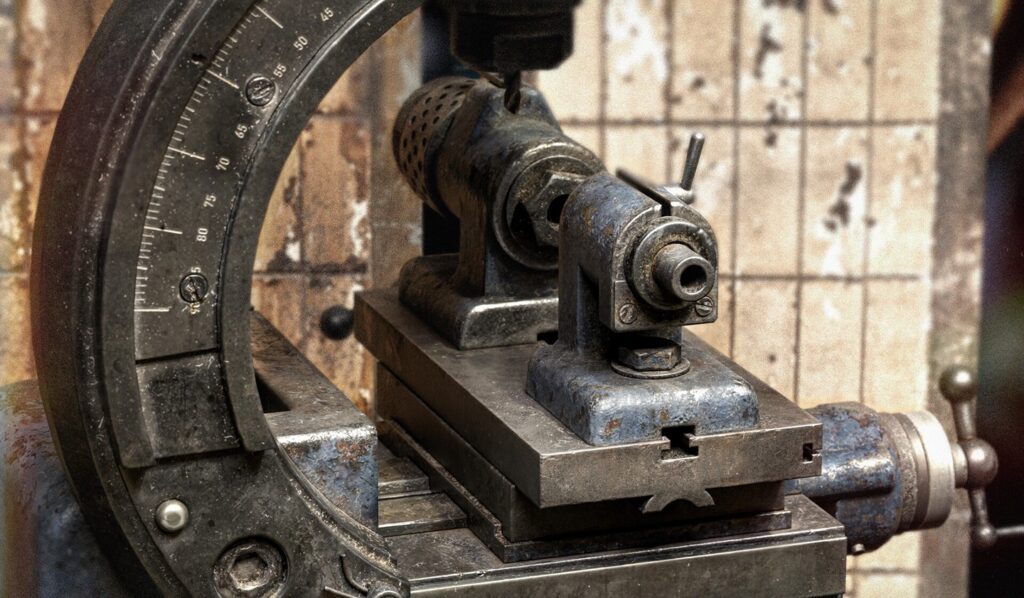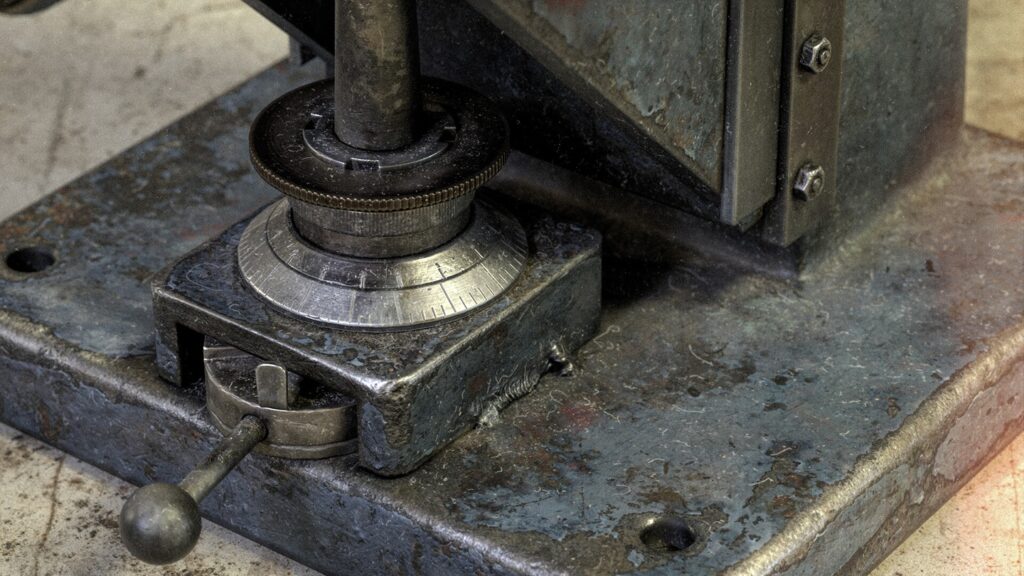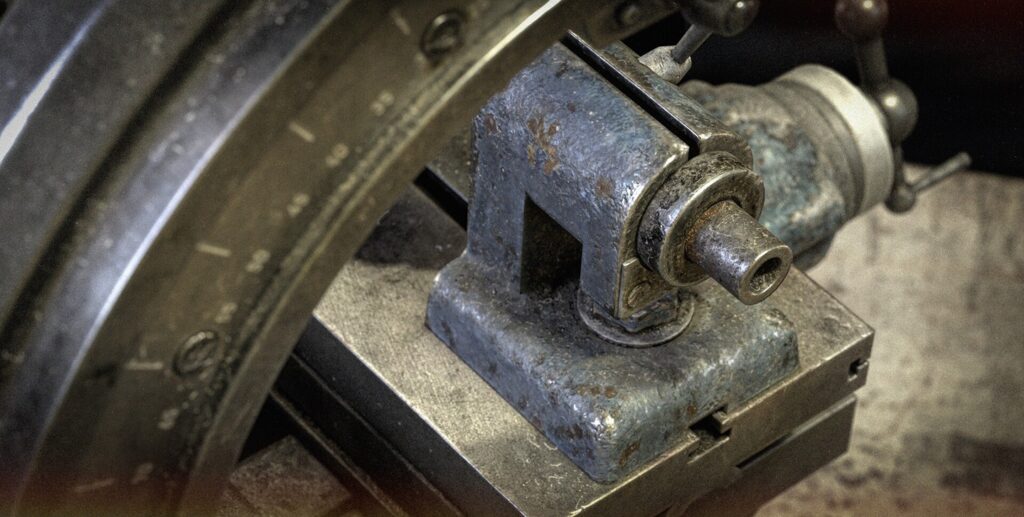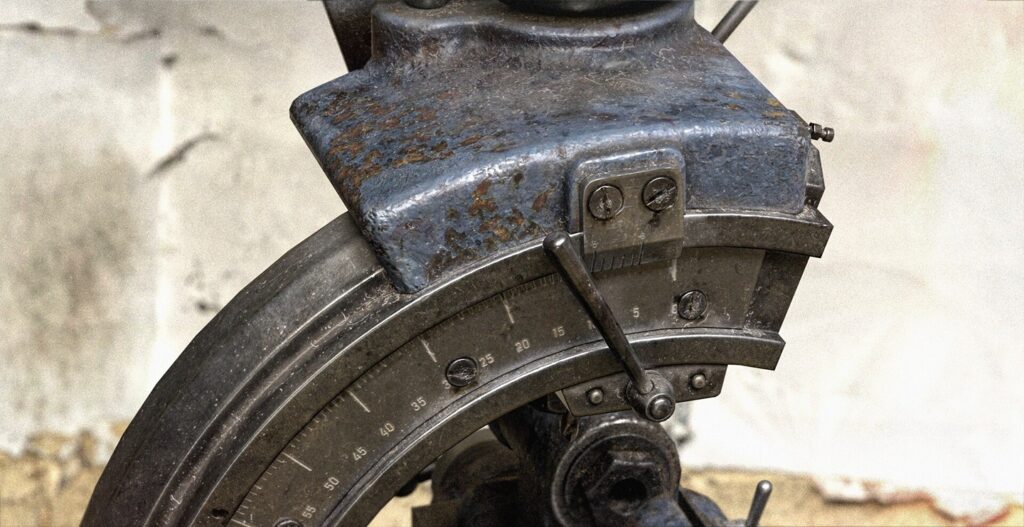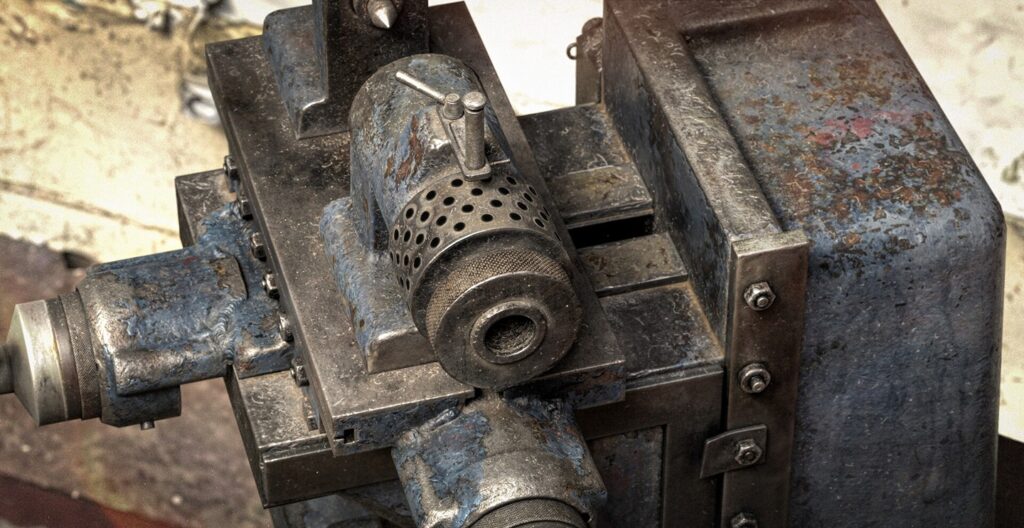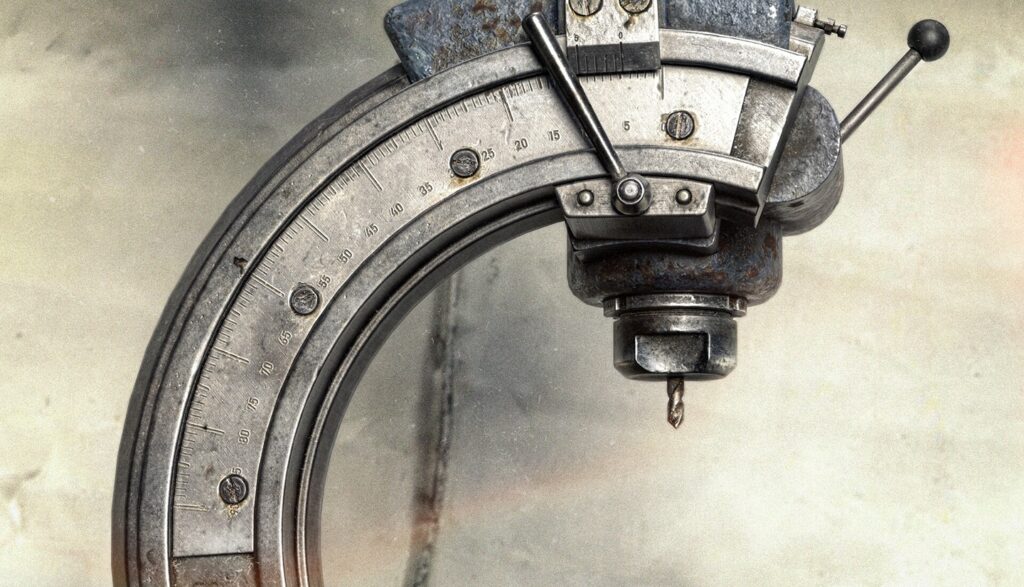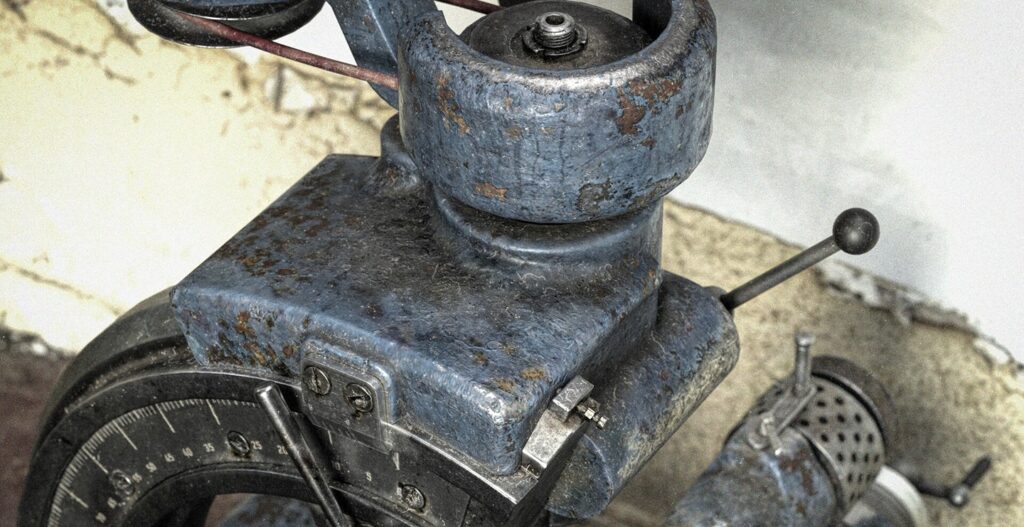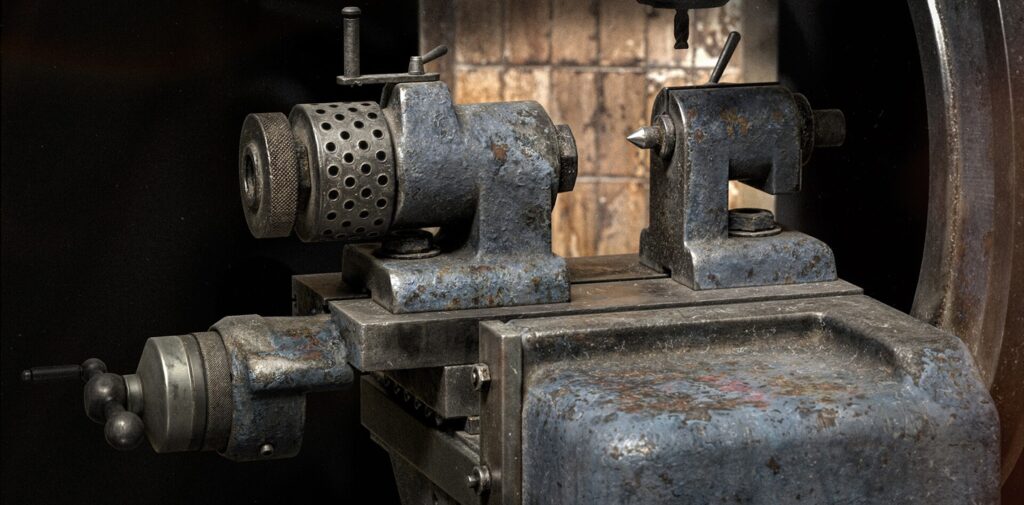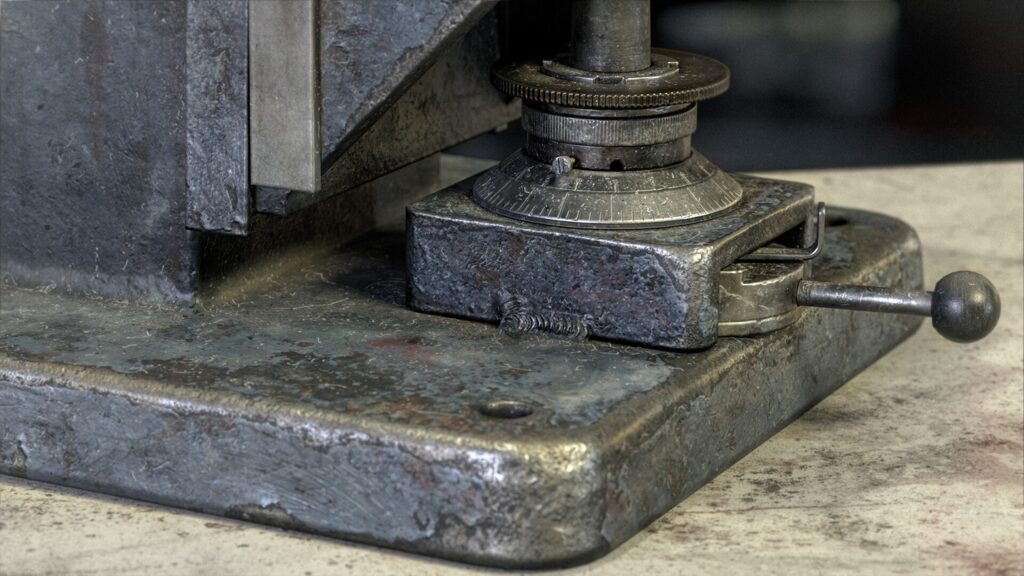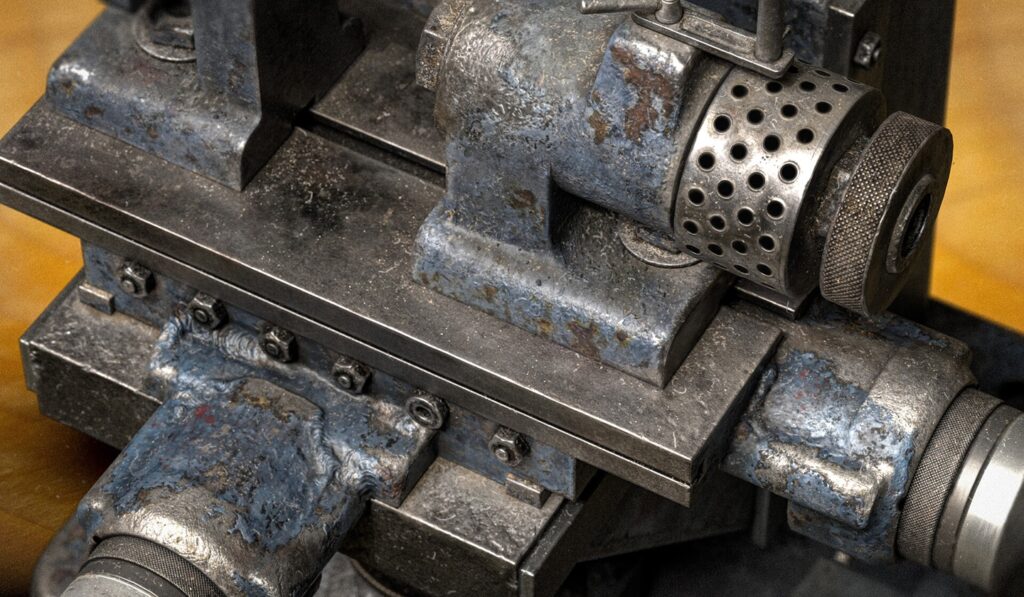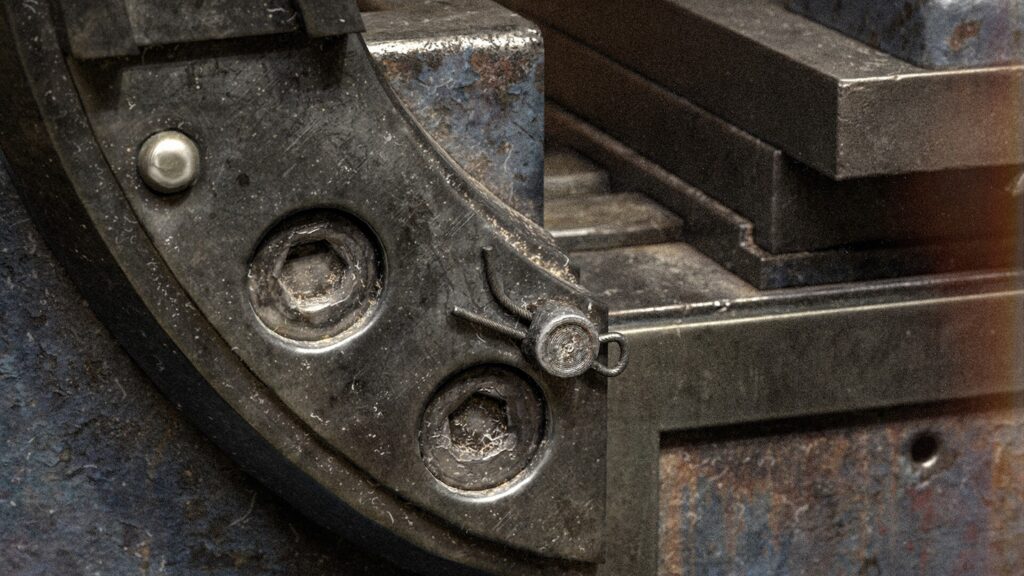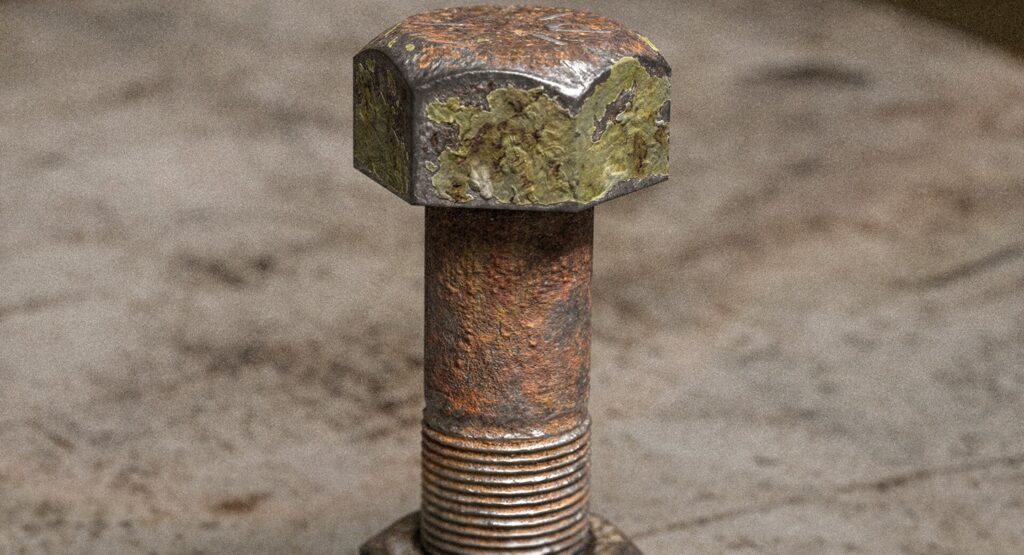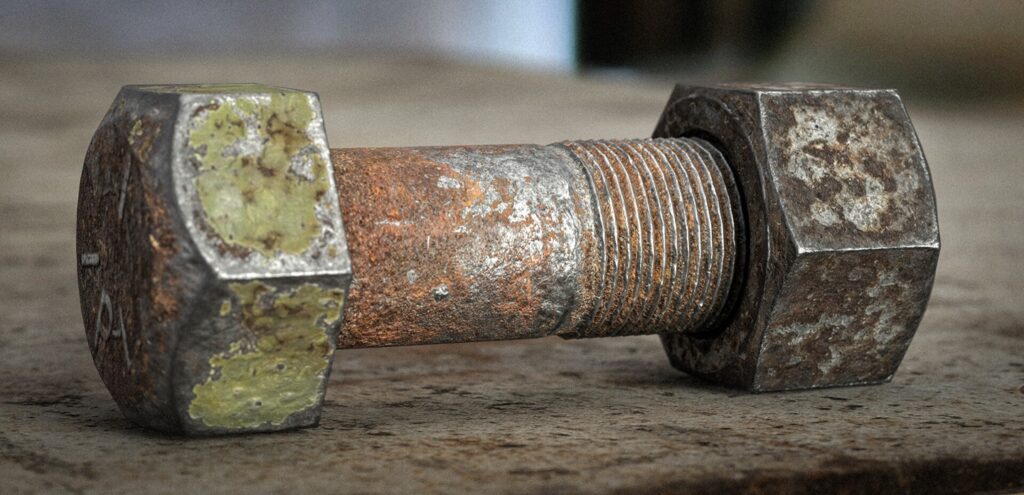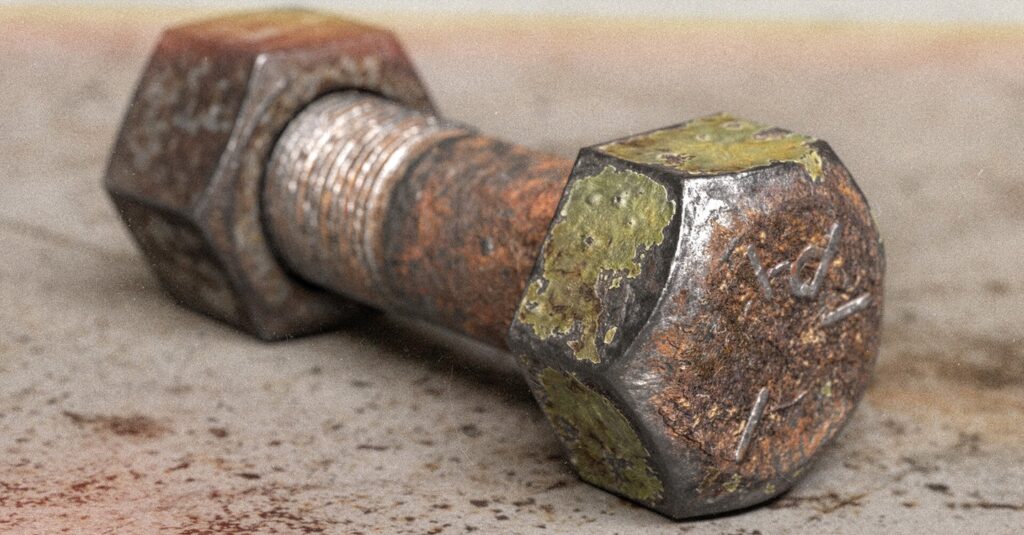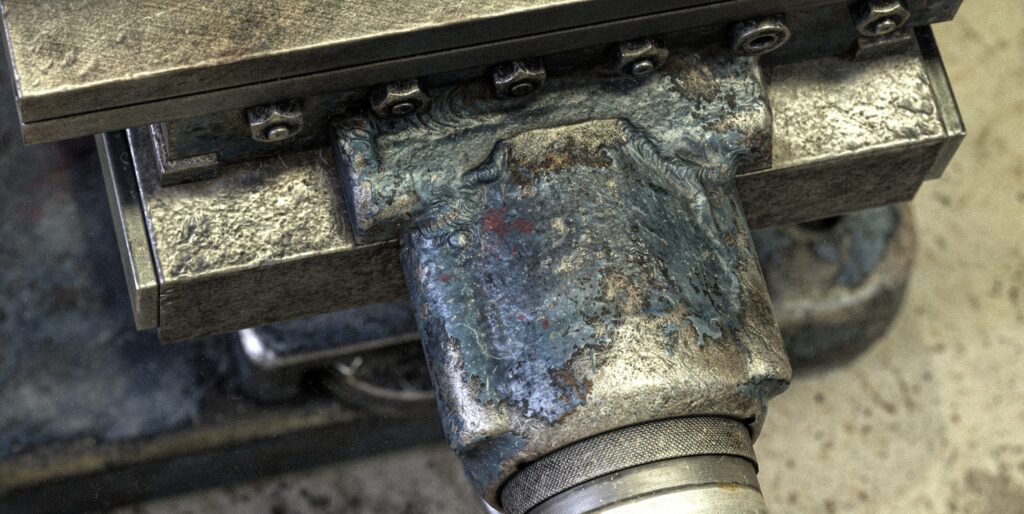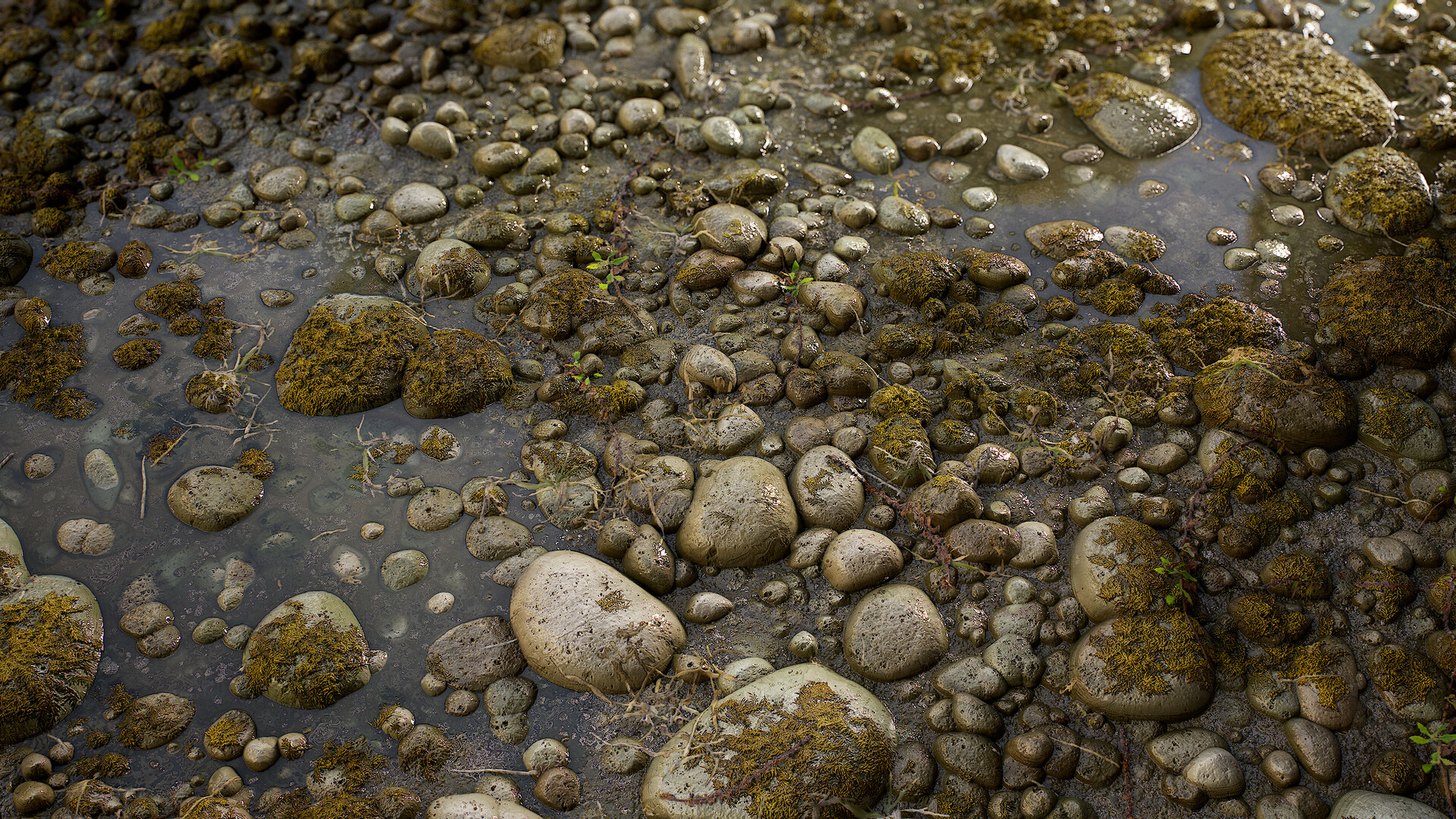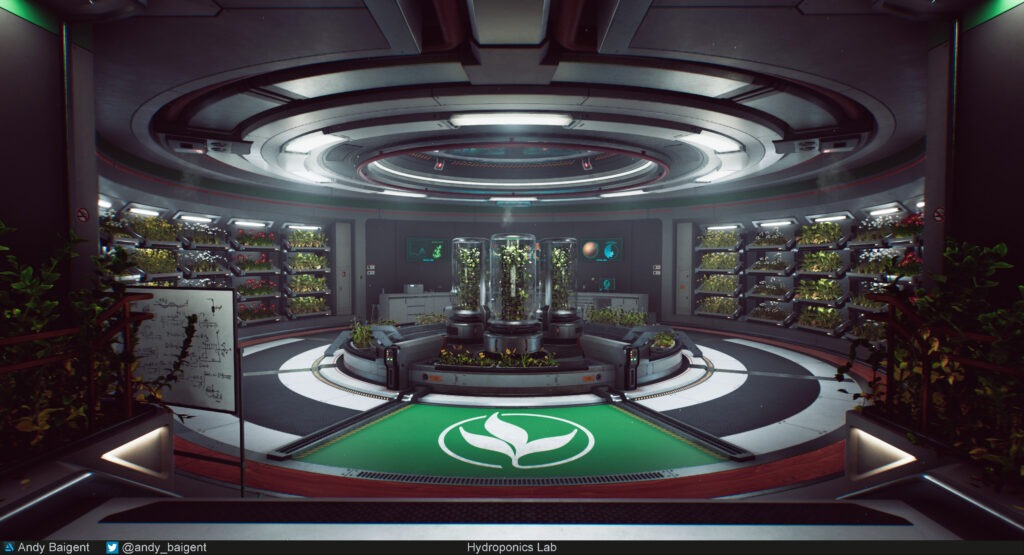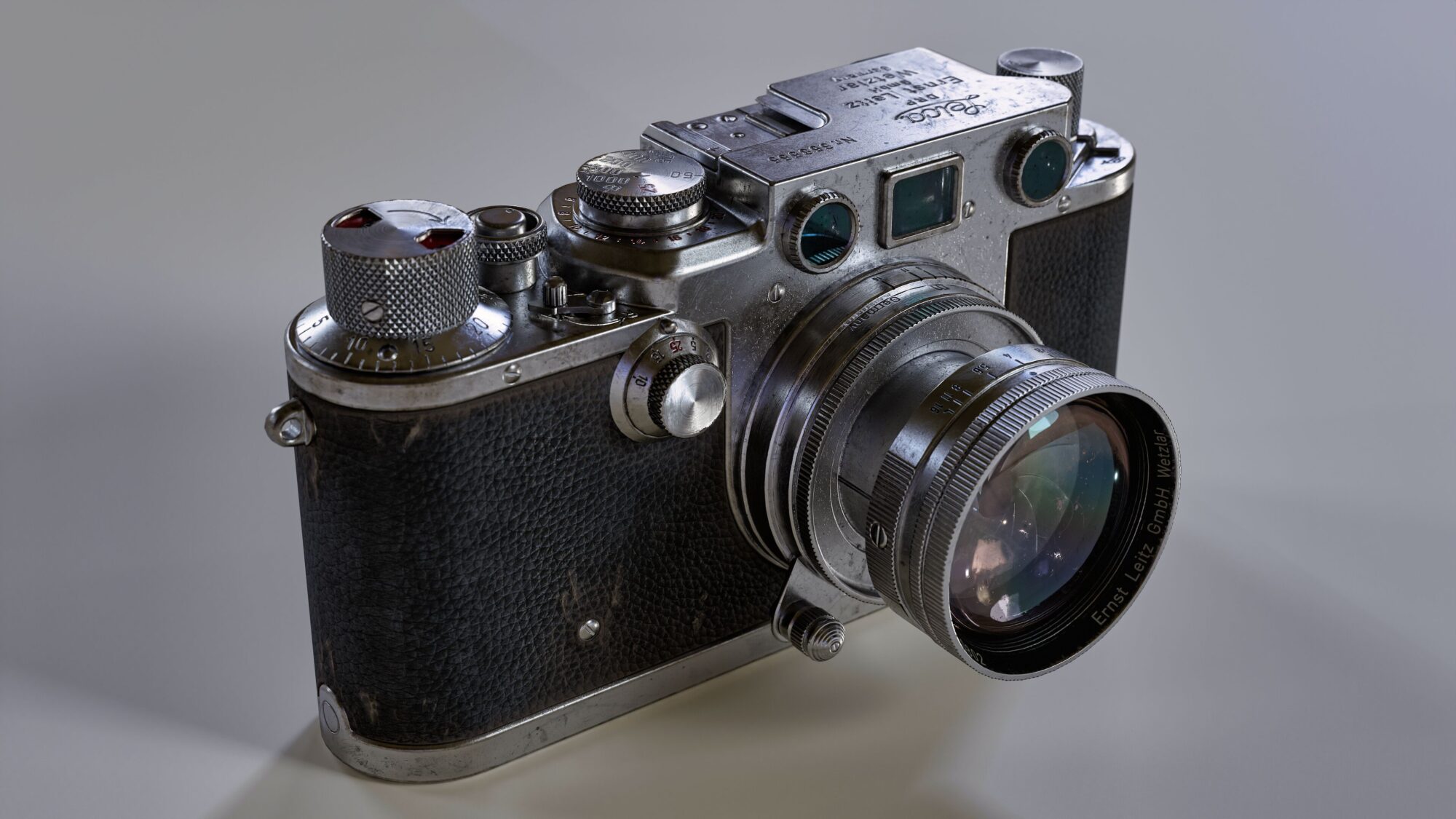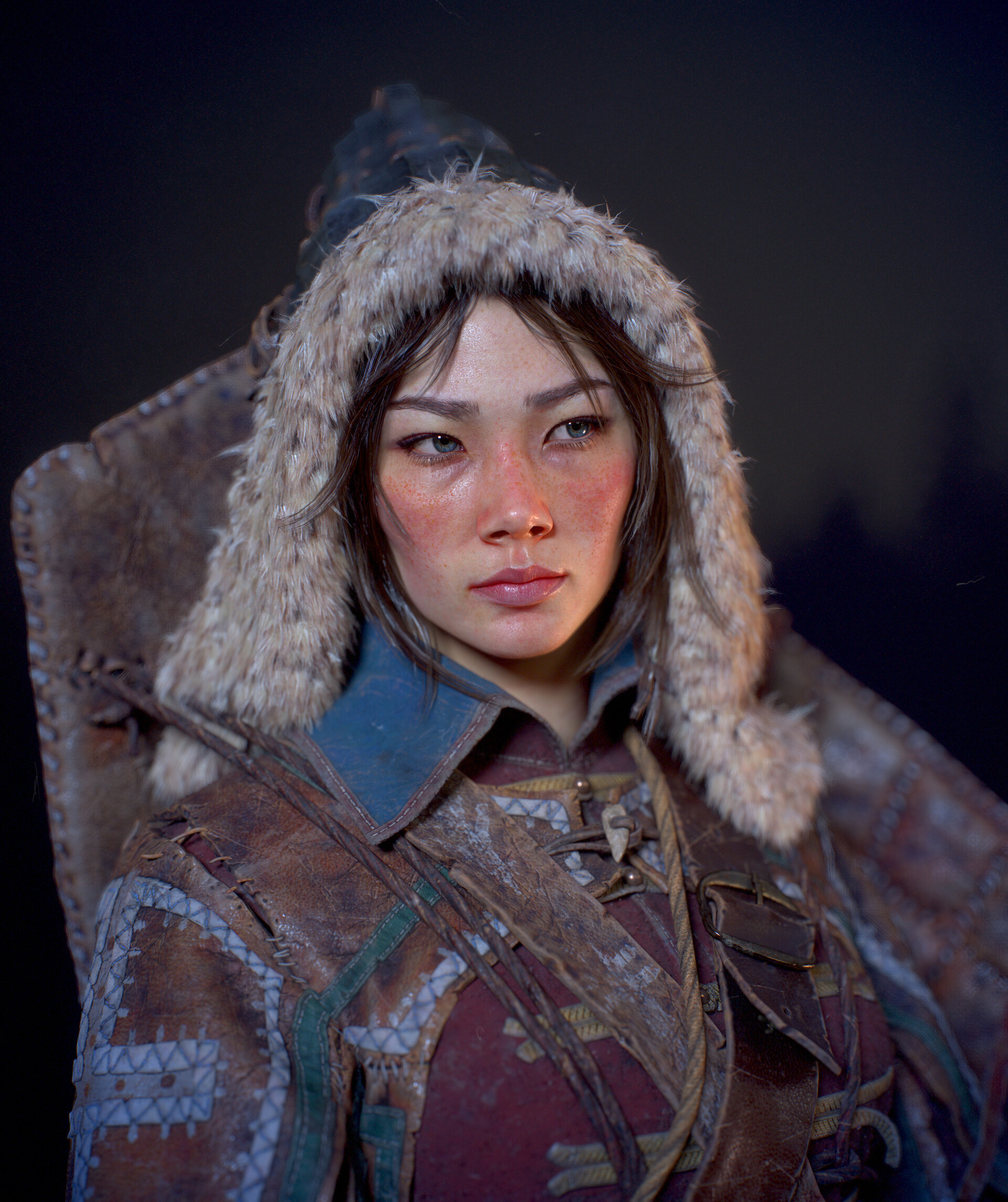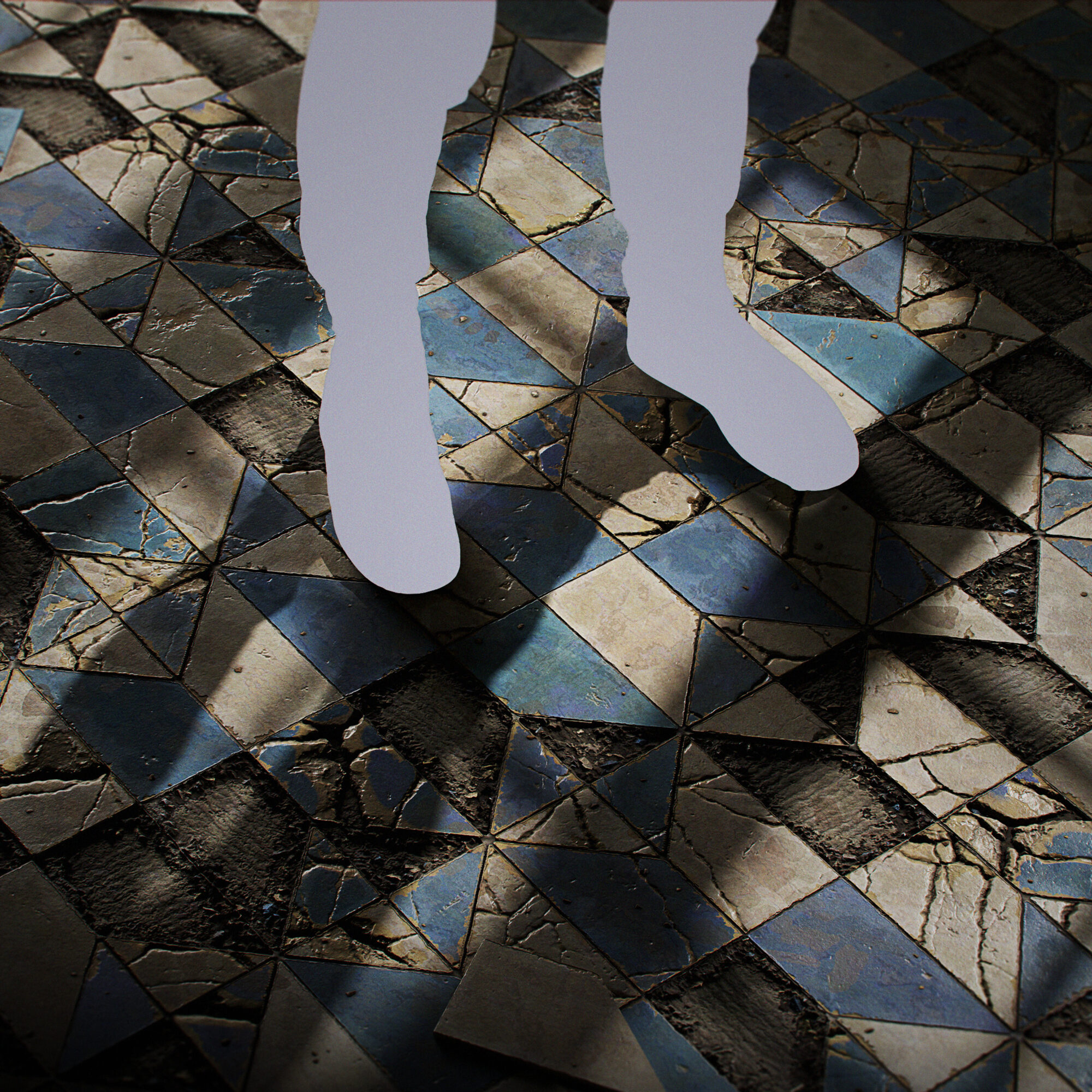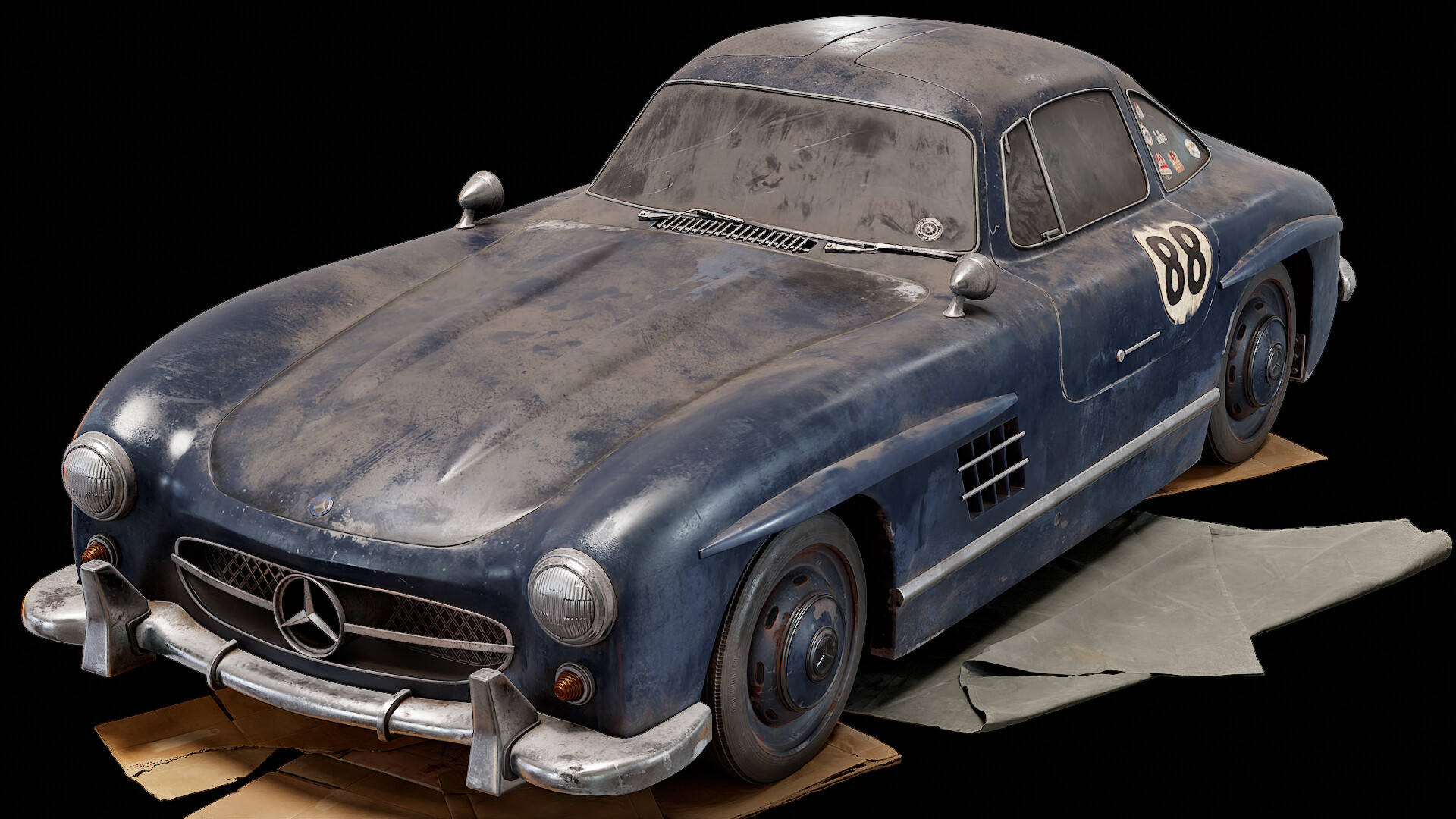Precision Milling Machine


Introduction
Hello dear friends.
My name is Lyuba and I have been doing 3D modelling for 2 years. Of these, I have one year of experience working as a weapons artist in a large outsourcing studio on a PC game.
Just a month ago, I was promoted to Middle Weapons Artist and began working on a new, larger project. I have extensive experience in design and classical painting, and I also used to do 2D illustration and conceptualization.
Project
Weapons are my main specialization, but I also have experience working with small props and large equipment.
My real passion, however, is texturing, which I find the most fascinating aspect of my work.
I’ve been painting for most of my life, and art has always captivated me. My dream is to continue improving my skills, exploring new disciplines, and working on major global projects with the largest studios.
Unfortunately, I can’t boast the same level of experience as the incredible specialists who have written articles here, from whom I’ve learned so much. My hope is that this article will be helpful to novice artists who frequently seek my advice and assistance.
I want to thank everyone who has appreciated my work and offered their suggestions.
For this project, my goal was to select something unusual and challenging—something that would make me think, “Oh, wow, I probably can’t pull this off!”
I chose the stunning NORA | Precision Milling & Drilling Machine. Staying true to my creative instincts, I decided to make some changes to the design by reimagining one of the handles and incorporating a wooden element.

Goals
I allowed myself to approach this project more freely because there were very few reference images available. The photos provided depicted only one machine, so I couldn’t see what this device would look like under different conditions.
Often, the images were incomplete or characteristically distorted. However, the main principle I adhere to when creating other works is to collect reference images from all possible angles.
For example, my PureRef weapon reference boards can weigh up to 3 gigabytes.
To be honest, I primarily use reference images for product modeling. For texturing, I usually assemble a separate, extensive reference board that includes numerous photos of similar materials.
Never limit yourself to photos of your specific product when texturing. Always seek out images of similar coatings and analyze the physical properties of those materials.
This way, you will never encounter the problem of incomplete close-ups when creating microfractures.
Getting Started
I start by placing the plane of the reference image, then I create large shapes and maintain the proportions. After that, I begin adding details. Once this is done, I will have a medium-poly version of the props, which I will use to create both a high-poly and a low-poly model.
At this stage, it is important to take your time and carefully study the reference. Additionally, during the initial stages of work, you may come up with ideas for how to add history and unique details to your product.
For example, I added adhesive tape to the NORA engine compartment and the wooden handle I mentioned earlier.
Since this project is being created for a portfolio, I make sure to emphasize the small details. I already have a good sense of what will be noticeable in the renders and what will not.
Nowadays, there is no reason to save polygons unnecessarily — always ensure that polygons are not visible on the silhouette of your model. Remember, the larger the shape of the curve, the more subdivisions it will require.
I set the general color fill for the model and step back to evaluate the silhouette and details, focusing on areas where I plan to make close-ups.
However, all the details you design should not interfere with the mechanical operation of the product. Also, avoid overloading the model with too many accents; otherwise, the composition will lack clarity, and you won’t be able to guide the viewer’s focus effectively.
Creating a High Poly Model
Once the blockout was completed, I quickly created a UV map based on the sharp edges. I then exported it to ZBrush and divided it into groups according to the UV maps. In ZBrush, I added the damage and dents I wanted to see on the model. The key is not to overdo the number of details but to ensure there are enough to be visible from all angles.
For this process, I primarily used the Standard, Dam Standard, Clay Buildup, Move, and Trim Dynamic brushes. These brushes were also instrumental in creating the welds, and I highly recommend Cut Metal and Welding Brushes for ZBrush by Andrey F. for welding details.
Some of the finer details are much easier and faster to create in a Subdivision workflow. Just don’t forget to include double support loops to maintain crisp edges.

One of the most important tips I received from my Lead Artist is to analyze the width of the chamfers. I previously attached little importance to the fact that different materials have different thicknesses, but as artists, we must properly exaggerate this for the sake of artistic effect.
For example, metal parts typically have sharp chamfers, whereas parts painted with a thick layer of paint or more roughly made should contrast with other elements and have thicker chamfers.
In games, chamfers are sometimes enlarged so they can be better seen from afar. It is also worth exaggerating small details to ensure they look better in the overall composition of the model.

Always imagine how the product could be made in production. This will help you understand how drills, machine tools, milling machines, and all other parts interact during the production of products.
It is important to remember that you can add many minor details at the texturing stage, which will be even more convenient, as you will be able to keep the details under control and manage them better.

I refined the tape and then sculpted the edges to simulate the deformations caused by aging everyday friction.
A wire with split wires inside was created in a Blender.

Low-Poly, the Creation of UV and Bake
My modeling process is not much different from how game dev artists work in studios. It looks like this: Mid-Poly – High-Poly – Low-Poly/UV. At the mid-poly stage, I display all the forms in their detailed versions.
I didn’t think much about topology, leaving it to the mid-poly stage. It was important for me to spend as little time as possible on all stages except textures and rendering.
However, I am now aware that I work quite slowly on the technical side, so I plan to improve my skills to increase my speed.
I start modeling with a real-size block to get as close as possible to the actual proportions of the product. The low-poly grid was built mostly from my grid, but some parts were created from scratch when the grid didn’t provide a useful starting point, such as the duct tape I exported from Marvelous.
Some details had to be worked out using the retopology method in Blender.

I refined the welds with geometry. No one would ever do that on work projects, but we can afford it for a portfolio.
I follow the rule of “what’s in the portfolio.” You should showcase the most detailed designs and not save triangles, because then you won’t be able to show as many interesting details. I used Boolean operations to create complex shapes.
I refined many chamfers and small areas with additional geometry, as I assumed this would be the central part of the model and would definitely be the focal point. The only thing I regretted was that I didn’t adjust the holes on the low poly version, which I only realized after looking at the finished renders.
I make sure to enlarge small details—bolts, thin shells, areas where text will be, and other intricate parts. I reduce the shells that will be turned away from the camera in the render—like the lower surfaces and shells in the holes that will be darkened by ambient occlusion (AO).
There is also a small life hack that really frustrated me at work before, but eventually, I fell in love with it: manual packing. Set the locations for the largest shells and those with complex shapes—everything that will pack poorly. In Rizom UV, you can group the shells this way according to your discretion.
For this model, since I knew I needed close-up renders, I chose a fairly high texel density and three texture sets. My texel density was around 100 pixels. I hope you haven’t missed the important point of setting up the model’s scale.
Firstly, it affects the texel density, and secondly, it will affect the render engine. After all, the camera and everything else will perceive the distorted dimensions of the model and create interference.
So, be careful with that. Personally, I made these mistakes in my early works and couldn’t figure out the scales and the correct operation of some modifiers in Blender, so always keep it under control!
UVing
In this model, I did not use overlaps, which I really like. In workflows, they help optimize the SE (space), but for my product in the portfolio, I wanted a lot of uniqueness.
Additionally, the optimization and increase of texel density are influenced by a more correct straightening of shells. To do this, I use Rizom. By the way, be sure to hide the seams in inaccessible places and try to place them one after another in adjacent parts.
It’s just a rule of good practice. To enhance the texture quality even more, you can reduce padding and margin. However, you can only use this when you are sure that the texture will not be reduced.
I usually set the lowest values to a couple of pixels for works in the portfolio. This is unacceptable for work tasks because, otherwise, your UV shells will just overlap, and everything will break

Baking
The next step is baking, for which I used Marmoset Toolbag. I baked a Normal map there with these settings. I always bake AO and Curvature maps in the same process, since the results suit me better that way.
These three maps are enough for me to work with generators. To bake the lighting, I also need a WSN (World Space Normal) and Position map, which are baked together during the process when my elevation map is ready.
At this point, I make a WSN bake and begin working with more advanced generators that help me create better lighting and reflection effects.
Texturing
My goal was to create an ultra-realistic object, observing all the rules of how damage would occur in real life. However, I also needed the object to be visually appealing and adhere to the principles of composition, ensuring it wasn’t overloaded or left with empty spaces, as can sometimes happen in reality.
I admit (and I’m aware this may earn me some criticism from senior artists) that I don’t strictly follow references. This approach gave me the freedom to design the parts the way I wanted them to be, rather than how they would appear on a real product.
Many artists advise against using other people’s work in art stages, but I recommend studying their work because I admire many talented, established artists. Naturally, this should be combined with photo references.
You can always blend real photos with techniques from top professionals, which can add a fresh perspective, stylish ideas, and useful life hacks for renderers.
Each object has its own history. So, during the stage of adding small details, it’s worth considering how to enhance or tell the object’s story. This is especially important if the object is shown in close-up during rendering, where small scratches, traces of dirt, streaks, dust, and other details will be visible.
When adding dust, scratches, scuffs, and other imperfections, consider where the object was stored, how it was used, and whether such scratches could realistically appear, given the item’s purpose and the material’s properties.
Also, be mindful of details that won’t be visible at all. I spent a lot of time working on details that were hidden by shadows or other objects in the renders. I’ll keep this in mind moving forward.
I’ve often noticed that many artists use the ACES filter, but I don’t like it for personal reasons. I feel that it makes the project look unnecessarily contrasting and artificial.
This is just my opinion, but I prefer to work in a lower-contrast environment, which allows me to achieve contrast in my Albedo channel without needing additional adjustments.
However, it’s important to note that ACES is necessary for some work projects and certain engines. But here, we are discussing my work at home, not in the office.
When texturing, I prefer to use Tomoco Studio HDRI. It provides neutral lighting that doesn’t alter the colors of your model and creates shadows that aren’t too sharp or too soft. Still, be sure to switch to other HDRIs during your work. This will provide more insight into how your product will look under different light sources.
Don’t forget to separate the details of your projects so you can properly texture hard-to-reach areas.

It is crucial to start texturing with a clear plan. First, you need to determine the structure of your surface. I carefully study references and aim to reproduce the surface of the material as accurately as possible.
One of the most important and challenging stages is the creation of the base material. For tile materials, you must learn how to create beautiful base fill layers.
These should be complex materials that meet the correct physical properties of the reference material.
To succeed, you need to work through the selection process and make many attempts. Creating a beautiful and detailed Albedo and roughness map is a significant part of this process.
I often spend a lot of time finding the right combination of procedural effects, noises, and patterns. My basic rule is to use fewer resources while maintaining physical accuracy.
Unfortunately, most of the material tutorials I’ve come across on the internet show how to assemble a complete material (base, wear, dirt, etc.), but not much attention is given to the thorough development of the base material itself.
At least, that’s how it seemed to me. There is a lack of detailed information online about assembling complex base textures procedurally, with more focus given to additional effects and eye-catching details.

The main task is to make it more interesting. Large planes often contain little information. Chips and dust collect in the corners, leaving large empty spaces on the planes, which glare evenly and look extremely boring.
Our task is to break these planes up with various details. These details may appear duller, or they may be shinier than the planes we are filling. It all depends on the visual appearance, so experiment with the shape of the spots.
It is very important that all parts have transitional shapes. It’s bad when the spots are too clear everywhere or, conversely, too blurred or indistinct. You need to create interesting shapes by combining clear and blurred areas with varying saturation and gradients.
After that, I add variety to the color to make it more interesting. I always look carefully at references and try to take into account color details such as scuffs on flat surfaces, gradients, darkening in the recesses, and scuffs at the edges.
Any color spots that could ruin a boring, monochromatic color map can help you.

A Rusty Bolt
The bolt is an interesting addition to my NORA machine. It was created using the spec-gloss pipeline, whereas the main scene itself is made with a metal roughness workflow. It was a small experimental project.
A few small rules for working with spec-gloss: the diffuse for metallic materials must be black, the specular controls the metallicity, and the gloss determines the refinement.
This was an unusual and difficult experience for me.
Before you start working with textures, you need to have a clear visual concept of what you are texturing. Imagine the degree and extent of rust and damage you will work with.
When texturing, it’s worth starting with the fact that the object should look realistic, but at the same time, it should be beautiful and aesthetically pleasing.

I believe that each material should be divided into large, medium, and small parts and fragments. I start with the large parts, creating the base materials that should look bright and good without additional details, dirt, and damage.
The base material defines the large shapes, so it is important to pay attention to the correct physical properties. While your base materials are not perfect, you should not proceed to create accent details.
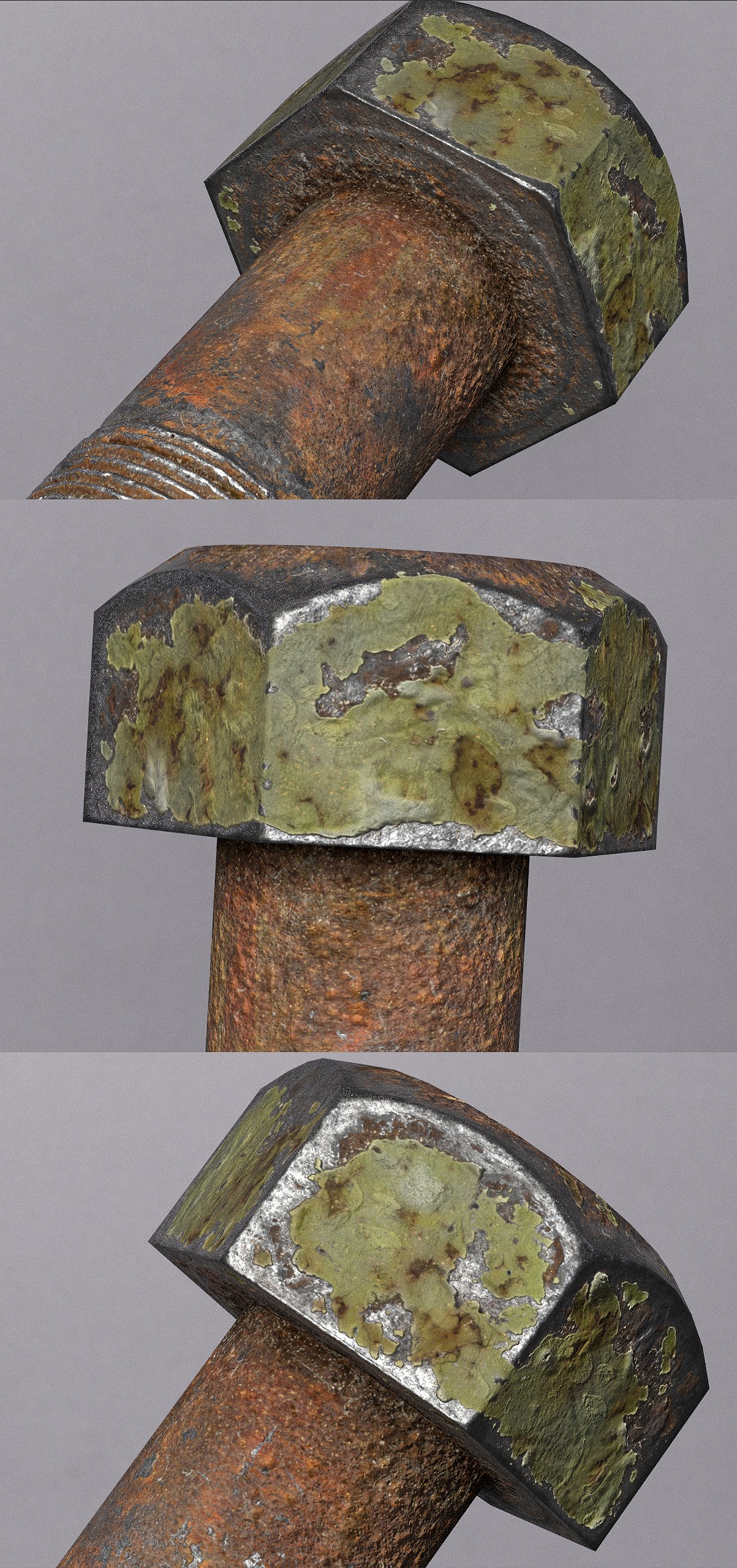
When creating the bolt, I paid attention to the distribution of rust and damage on the surface of the threads. Please note that there won’t be too many spots on the threads, and they will be concentrated in the recesses because the protruding parts of the teeth will be worn down to bare metal.
We will focus the damage mask on these areas due to frequent use. You can set the damage to the circular threads using the Metal Edge Wear generator to save time and avoid having to manually paint the circular patterns.
However, be sure to add manual patterns to create interesting chips and details in the shape that will catch your eye.
Damage
The damage is one of the most striking components of the appearance of the object. The damage should be located in logical places—on protruding parts, in areas that most often interact with the environment.
If the part was rubbed against clothes or gloves, a smoothly worn, gradient area will form. If the part was hit, the paint will chip off, creating a clear, ragged chip. If the part was constantly used in one way, there will be a sharp contrast at the boundary between the material and the damaged area.
It is also important to mention a very popular texturing approach, where you start with a factory-clean material and gradually add the damage described above. This works well for slightly damaged items.
However, when your object has strong and noticeable damage, as seen in my project, the outline of the damage should be the first consideration in your work.
The damage to the surface was my personal decision and was done to add interest to the model. However, in real life, it is very difficult to damage the machine since it has a solid material surface.
I think we would never see such a high level of damage in reality, but I wanted to work with these masks. I tried to logically approach the analysis of the shape of the damage and, subsequently, the contamination.
Remember, the key to location contrast is that pollution typically gathers on the planes and articulation points of objects. Try to avoid placing them on edges. You can save time on manual work by using the Curvature generator in Subtraction mode, which helps remove excess dirt from the edges—areas where, logically, damage should accumulate.
I enjoy adding textured damage details. They have different roughness and albedo. These include scuffs and polishing, which are opposites in their properties. Also, it’s not always obvious, but many people don’t think about this—damage isn’t always located in the most prominent places.
Especially on very old or heavily used objects, paint chips, small scratches, and other damages are scattered across the entire shape, even in areas where fixed parts make contact.
Additionally, I want to bring up an issue that my industry friends and I often argue about: whether metals can have only values of 0 and 1. In reality, metals can have a range of values. The key is to avoid extremes and work within a range of 0.2 to 0.8. Strict 0 and 1 values are only necessary for specific projects, depending on the engine and platform of the game. But for a portfolio, we focus on maximum realism, which includes material mixtures. There are no pure 0 or 1 values in anything.
The goal is to create a render that looks good. Although some may disagree with me, the main thing is not to show this article to my boss!
My favorite tools for creating cool shape transitions are anchors and passes. With these two tools, you can create an incredible array of cool details.
For example, they help to create peeling paint edges, color gradients, bleached old coatings, dirt collecting under the peeling paint, and many other effects.
By the way, one of my observations is that the texture of plastic may have softer, lower-contrast patterns compared to metals and their chemical coatings.
Plastic can also have negative height textures, while metal tends to have positive height, especially when working with spraying and chemical reactions.
Quick tip
Pay attention to the interesting patterns you can create with your damage. You can break away from direct reference and organize your scratches into a visually appealing group because chaotic scattering without composition won’t look great.
For example, my favorite rule when emphasizing edges with color and polishing is to break the uniformity of the chamfer with interesting scuff shapes.
Tree
I am equally attentive to all channels when texturing. Albedo and roughness contain the most detail. On metal, it’s important to highlight the main transitions of materials, but on the first two channels, any changes in texture should be indicated.
The richer the color and shade variations, the more variety there will be from different viewing angles and lighting.
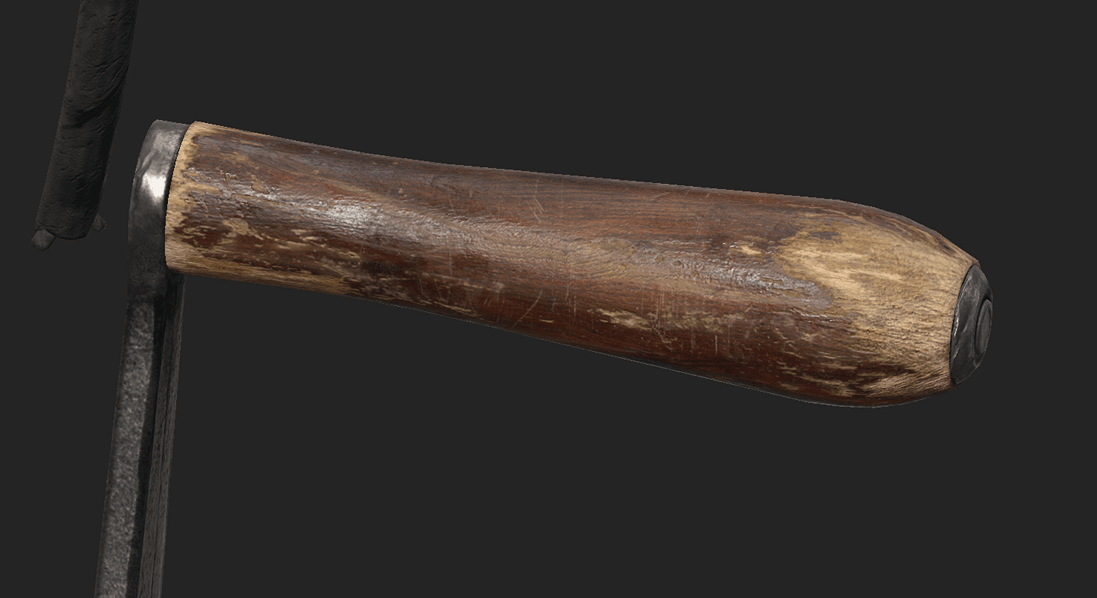
I always use height information to add a sense of tactility to the subject. Observe how the addition of height information affects the overall appearance of the material.
The secret lies in the contrast of heights. A lacquer coating has a rise and a greater glossiness, while bare wood with damage has an uneven structure, is more matte, and looks rougher.
The first thing I did was indicate the values of the lacquer. I started with a shiny base layer, followed by several rougher layers to create damaged corners.
After the varnish was applied, I further enhanced the overall weathering and damage by adding larger scratches, color variations, and other surface defects. I began by adding minor wear to the surfaces and sharper damage around the edges.
The first layers consisted of a rich red base, lighter roughness options, and some protruding wood texture. I also added a reflective layer of varnish.
The contrast was introduced by significantly darkening the grooves of the handle and brightening the most exposed areas. Using the same technique, I made some changes to the masks, as such deterioration happens unevenly.
The idea is that dirt will collect in the recesses, and frequent handling will wear away the surface layer, exposing untreated wood underneath.

We can see several types of damage on my fictional wooden handle. I’ll try to explain them. Sometimes it’s difficult for me to explain my actions because I like to combine unusual elements I find in references.
The most noticeable feature is a large chipped varnish area, revealing rough bare wood.
It’s important to focus on the shape and silhouette of the spot, rather than the filling material. I always work with the form first and then with the material. Often in art, the shape tells us more than what’s inside, just as our brain first reads the contours and then looks inside to identify the object.
The large and small shapes are what shape our overall perception of textures.

It is also important to use color contrasts. I always add large color contrasts and then split the fill planes with shades; they should be quite noticeable. I often use filters like Galvanic.
Don’t forget to add a roughness map along with the color change. Without large patterns from afar, the material will turn into a very boring, full-grown frame.
Your gaze will have nothing to cling to. At the same time, without small and medium-sized shapes, your material will become just a square, filling-plane base. Pay attention to how the wood looks with different coatings.
The damask of the wood also has different shades; sometimes it is lighter, and other times darker.
Dirt and Dust
It’s not just the damage that makes the texture “tasty.” It is necessary to understand that many different stains, dirt, shiny, and matte areas accumulate on real objects.
The best way to evaluate the variety of textures is by looking at roughness; it should be filled with various details, contrasting smooth transitions, and elements that will make the model artistically interesting. I imagined how long the machine could stand without use.
How could it get dusty with coarse and fine dust? How could fibers and particles that fly in a dirty room stick to it? How could large drops of oil or chunks of solid materials fall on it?
For some types of dust, the basic Dirt and AO generators will work, while in some cases, you can manually paint it in for a more personalized touch. This is one of my favorite stages. At work, I joked with my colleagues that I wanted to be called a “dust artist.”
In this project, I have more than seven layers of dust that I added to the finished surface. But there were also impurities that interfered with the material during the intermediate stages of work.
These include layers like spraying, hairs, particles, dots, and so on. But please note that this should only be done on old items. It should not be applied to weapons or objects that are actively used.
There should be traces of constant use—fat spots, fresher dirt, and so on. Be able to distinguish when and what is appropriate to use. Remember to consider the mixing boundaries between objects—dirt tends to accumulate at the intersection of different parts of the object, and dust lingers in certain places.
Smooth transitions between details contribute to a more realistic appearance.
When adding dust, scratches, scuffs, and other details, it’s important to consider where the item was stored, how it was used, and whether such scratches could appear, given the purpose of the props and the properties of the material.
Of course, you should not overdo it with small details. It may seem that I’ve added too many details, but the selected final light setting should be taken into account. With certain lighting and viewing angles, some details may be barely noticeable, while others might not be visible at all.
Here’s a life hack for those with a weaker computer, like mine. I’m a bit ashamed of my setup, as I’m working on an assembly that’s over four years old. I texture in several different Substance Painter (SP) files and periodically combine my uploaded textures into a single file for the render engine to track the process.
I also hope that each of you knows the importance of cleaning out the Remove Resources file. Before doing so, make sure to collapse the Paint layers into the Fill layers, which will make your file much easier to work with, especially if you’ve drawn a lot by hand.
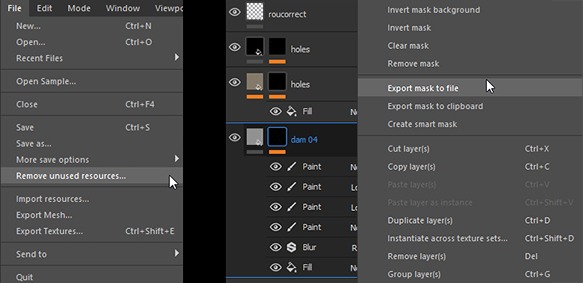
The dust should not be uniform; in some areas, it gets clogged more, while in others, less. Here, it is important to consider the artistic aspect and focus on real examples or previously textured references.
The dust must be painted into the recesses and textures, enhancing the albedo map and making it more beautiful and interesting. Working with our favorite generators helps in this process.
I can compose several smart masks and generators with Subtraction and Addition overlay modes, then finish drawing the resulting masks using brushes or custom stencils. It’s necessary to strive for an overall realistic background while keeping in mind the importance of unique details in masks.
It is important to monitor the scale of the hairs and dots—this layer should be clearly visible from a distance, without making the hairs too long or the dust motes too bright.
It seems to me that it would be a big omission not to use as many types of dust as possible. I usually start with the general dusting, which is typically created through Dust and Dirt generators, and then use soft brushes to shape the mask more interestingly. In this layer, roughness is incredibly important, as it will create interesting highlights and blurring in light and shadow.
Next comes a large layer of old dirt, which is clogged into recesses and crevices. It can have many shades, different saturations, and interesting height differences. I like to mix shades of green and brown into it, using sharper brushes and applying it locally as an accent.
Then we move on to the most noticeable dirt, where real creativity begins—hairs, grains of sand, dots, particles, and large chunks of dirt. Be sure to mark each layer on all channels so that your details play and do not disappear in any light transition.
Always make sure your dust is not metallic and doesn’t shine according to the roughness map. Keep yourself in check and don’t get too carried away—remember the 20/80 rule.
Rendering and Post-processing
Two components are important in rendering: the adjustment of the light and the adjustment of the camera to the parameters that you want for the finished picture. The first thing I adjust is the camera’s viewing angle.
I choose lower viewing angles because I don’t like the distortion effect that high viewing angles cause. I usually keep the field of view between 5-15 mm and 200-250 mm, as it looks the most realistic to me.
I use reference images to adjust the light. For studio shots, I use less contrasting and calm HDRIs. For outdoor renderings, you can choose bright, saturated light sources that can be positioned at different angles. I advise you to check out the Poly Haven website, which provides many useful resources.
I like to add extra light to highlight bright contours and details. For a more realistic rendering, I ensure there is enough contrast between darker and saturated areas of the render.
This gives a wide range of values, from light areas to dark shadows, making your product look more robust and attractive against the general background, resulting in a more pleasing picture.
Rendering disproportionately long or tall objects in an interesting way can often be challenging. When creating a frame, you will have to decide what to keep and what to discard.
Excessive negative space can also create problems. Things can get even more complicated if the scale of the main object is not properly conveyed.
Be sure to think through the narrative of your renders. For example, I wanted to capture the atmosphere of an old factory or industrial space, with dirty concrete walls and countertops.
This fits well with my concept of a neglected atmosphere.
The visibility of certain coating effects (and defects) depends on the direction of the light. For example, roughness might appear and create glares only under directed light, while color shades might disappear.
In contrast, when an area is in shadow, the roughness may be less noticeable, but here we can distinguish more shades on the albedo. Roughness often looks different depending on the light source and HDRI.
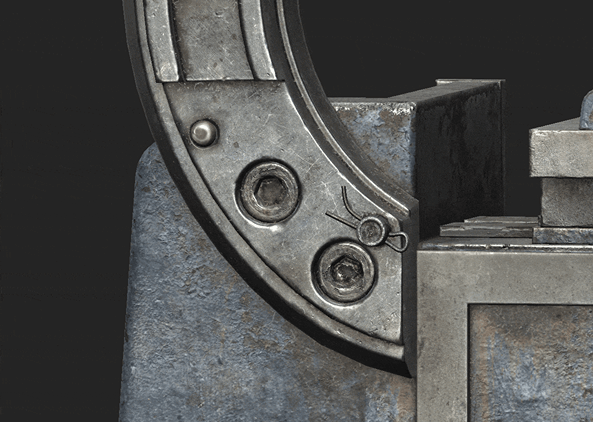
My friends often have a problem when they don’t have an idea for a render. In such cases, I always tell them to start with simple renderings on a white background. This always helps them get involved in the process.
My rule is to always have some of the simplest shots of your project on a neutral background, where there are no distractions. After that, you can start looking for inspiration from various photographers and talented artists on the artstage.
I’m constantly looking for inspiration from others, and I think it’s the right approach. I myself have also received thanks several times for some of my ideas that others have used in their own renderings. It’s also important to communicate with your colleagues.
Once you’ve made a variety of renderings and shown your model from all sides, you can proceed to post-processing. By the way, always remember to submit several large full-length shots of your product, along with a few close-ups.
Personally, I like the rule of using several different backgrounds for rendering. I usually take a few simple shots on a black or white background, and a few shots in the interior or outdoors.
This way, your viewers will be more interested in viewing the resulting images. I particularly enjoy horizontal wide renders, as they look photogenic and cinematic.
In general, I advise you to experiment and apply all your wildest ideas. Separately, I would like to mention the use of additional resources. I used the Megascans resource for the background, as well as for some basic properties, such as dust and basic grunge for plastic.
The use of scanned elements or photographed details adds realism to the asset.

Let’s go back to Photoshop. I love the sharpness and noise filters. I think you’ve noticed it (haha). I usually add contrast and sharpness to my shots, and I like to add color noise and filters in the style of old film photos to enhance the cinematic aspect of the shots and help focus on certain parts of the render.
It creates an interesting atmosphere for me. This is the same creativity as all previous work, so just listen to yourself and try using Camera Raw.
Final Words
Sometimes it can be very difficult to bring your project to an end, especially when it has already caused a lot of stress and is no longer progressing as it did at the beginning.
For this reason, avoid taking on complex projects right away. Start with bright, but small products. There are many amazing objects that are not at all complicated in shape.
For example, I’ve seen many screwdrivers, hammers, knives, and similar items. These objects have simple shapes, allowing you to showcase your creativity and enjoy the process of drawing.
It will be rewarding if you understand that the main task of an artist is to find beauty in ordinary things. Only after spending a lot of time analyzing references will you truly understand the material and be able to create outstanding work that evokes positive emotions in both you and the viewer during the presentation of your work.
I run my own small blog where I share my experiences and successes. I am aware of the current crises in the industry. To be honest, at first, I had a complex, comparing myself with other specialists, and for this reason, I didn’t consider myself worthy of rest, which led me to burnout.
I will honestly say that without a supportive community, you won’t be able to achieve much. I am 99% grateful and indebted to my comrades, with whom we have developed and helped each other.
I also recommend developing your soft skills. You should avoid conflict with people, refrain from speaking out sharply on the internet, and not give unsolicited feedback.
This is basic internet etiquette. Always support other young artists and help them, and you will find a large circle of acquaintances. After all, you may become colleagues at some point.
I remember how wonderful people helped me along my path, and now I’m very happy to help beginners. Be grateful for the help you’ve received and communicate more to help create a good community, because, in reality, there are very few of us.
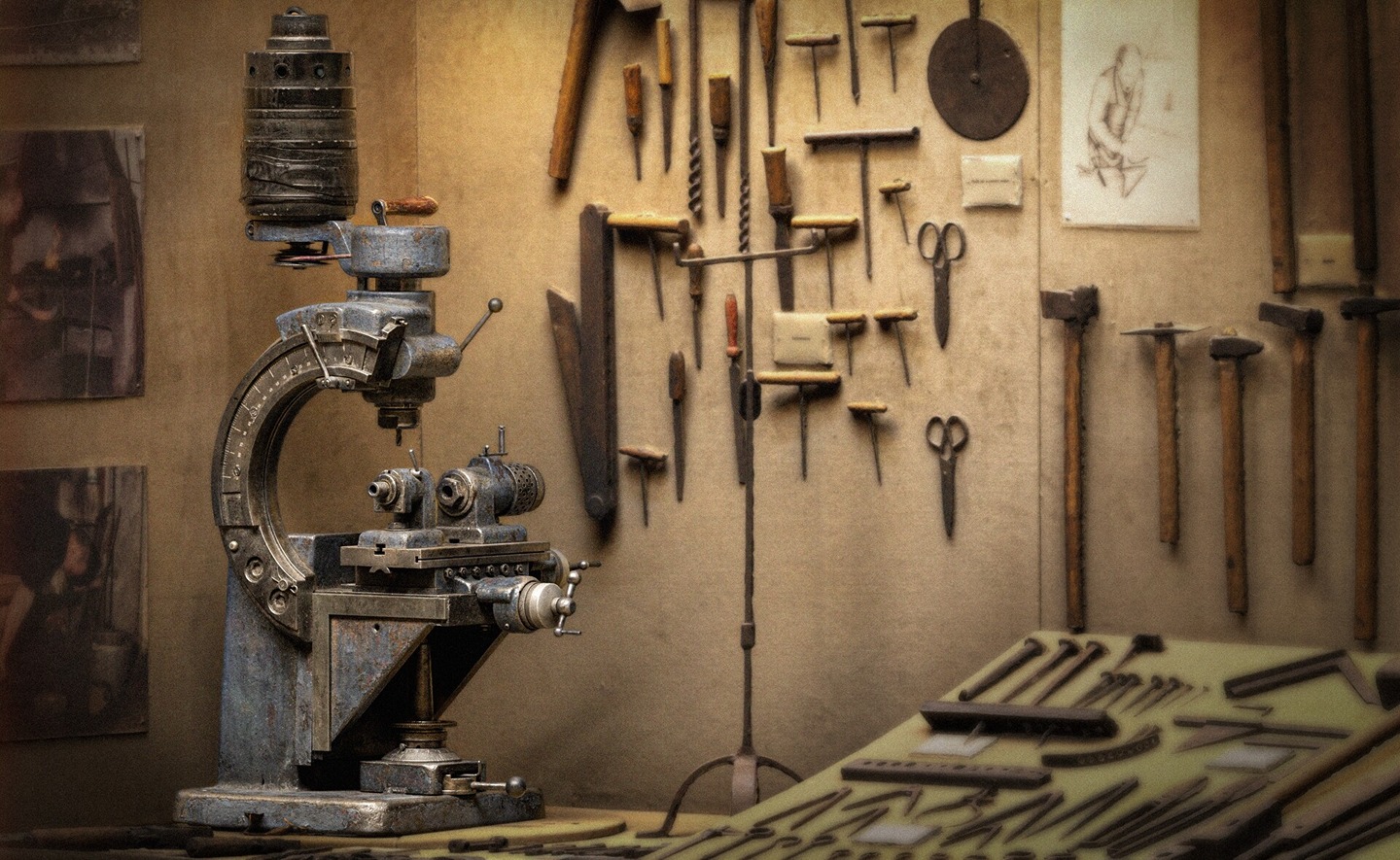
Then there’s something called the “survivor’s mistake,” where people willingly share positive experiences but don’t talk about their mistakes and difficulties. Because of this, it seems that everything happened easily and quickly for everyone, as we only see the stories from one perspective.
If you are looking for employment, remember that a potential employer will want to see specific information in your portfolio. This includes details of your technical skills, so be sure to showcase your knowledge of topology, mapping, and other technical aspects, along with your renders.
In general, focus on adding as much data as possible to demonstrate your knowledge from all angles, and not just showcasing textures in your images.
Good luck to you. Believe in yourself—discipline and hard work will make you a professional. Many thanks to GameArtist for giving me the opportunity!
Feel free to contact me on ArtStation, LinkedIn or Discord (rose_madder) if you have additional questions.
There are still many things that I need to learn and improve, but I hope you find something useful in the insights shared in this article.

